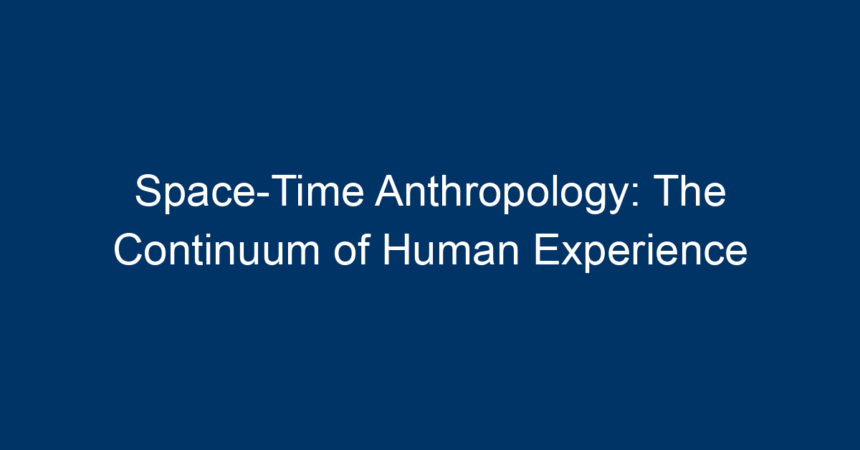In an increasingly interconnected world, the way we perceive time and space plays a crucial role in shaping our human experience. The fascinating field of space-time anthropology emerges at the intersection of cultural studies and physics, offering insights into how various societies interpret their existence in relation to the dimensions of time and space. This article will explore the continuum of human experience through the lens of space-time anthropology, diving into its theories, implications, and how it can enhance our understanding of culture and identity.
Understanding Space-Time Anthropology
What is Space-Time Anthropology?
Space-time anthropology investigates how human beings perceive and experience both time and space within cultural contexts. This discipline extends beyond mere sociological studies; it delves into the philosophical implications of how individuals relate to their environment over time. At its core, space-time anthropology seeks to answer the question: How do different cultures interpret their existence in the vast tapestry of time and space?
Historical Background
The concept of space-time has its roots in physics, particularly in Einstein’s theory of relativity, which revolutionized our understanding of time and space as interconnected entities. In anthropology, scholars such as E.E. Evans-Pritchard and Claude Lévi-Strauss paved the way for integrating these concepts into the study of human cultures, laying the foundations for contemporary space-time anthropology.
The Interplay of Culture and Perception
Cultural Constructs of Time
Different cultures exhibit unique perceptions of time. For instance, Western cultures generally adopt a linear view, seeing time as a finite resource that moves from past to present to future. Conversely, many Indigenous cultures perceive time as cyclical, where events and experiences are interconnected and repeat in various forms.
This divergence in temporal perception influences various aspects of life, including:
- Rituals: In cyclical time cultures, rituals often mark seasonal changes, emphasizing relationships with nature.
- Work Ethic: Linear time cultures may prioritize productivity and efficiency, leading to a more structured approach to work.
Spatial Awareness and Human Behavior
Similarly, spatial awareness is integral to understanding how cultures interact with their environment. In urban areas, space is often commodified, resulting in a detached relationship with one’s surroundings. In contrast, rural and Indigenous communities often maintain a harmonious connection with their natural environments, where space is imbued with significance and history.
Interaction Between Time and Space
Space-time anthropology emphasizes that time and space are not separate entities but are interwoven through human experiences. This intertwining leads to varying cultural expressions and practices:
- Architecture: The design of buildings reflects temporal values and spatial consciousness. For example, ancient structures often align with celestial events, linking the physical space to cosmic time.
- Storytelling: Cultural narratives often incorporate both time and spatial dimensions, inviting listeners to not only "see" the story but to "experience" it across different realms and times.
The Global Context: A Modern Perspective
Globalization and Space-Time Dynamics
Globalization has rendered the world smaller, compressing the constructs of time and space. Instant communication and travel have altered how cultures interact, leading to hybrid identities that embody traits from multiple time-space frameworks. This phenomenon raises critical questions about how traditional societies preserve their cultural identities amidst growing influences from the global community.
Technological Advancements and Perception Shifts
With the rise of technology, our experience of space and time has undergone significant transformations. The digital age has created a ‘virtual’ space that transcends geographical boundaries, challenging conventional notions of physical presence and temporal sequence. This new dimension invites a reconsideration of existing cultural frameworks and poses unique challenges for anthropologists seeking to understand human interactions in this new context.
Climate Change and Environmental Awareness
As we face climate challenges, space-time anthropology can aid in understanding varying cultural attitudes toward environmental stewardship. Different societies’ relationships with their physical surroundings influence their responses to ecological crises. Traditional knowledge and practices offer invaluable insights into sustainable living, illustrating the importance of rootedness in both time and space.
The Role of Ethnography in Space-Time Anthropology
Methodological Approaches
Ethnography remains a key tool in space-time anthropology, allowing researchers to immerse themselves in communities and observe the intricate dynamics of time and space in real-life settings. This qualitative approach enables anthropologists to capture the richness of human experience, yielding insights that quantitative methods may overlook.
Case Studies
Several ethnographic studies exemplify the richness of space-time anthropology:
- Indigenous Time-keeping: Observations of Indigenous communities reveal how their cyclical understanding of time informs agricultural practices, reinforcing a deep connection with their environmental cycles.
- Urbanization Studies: Ethnographies of urban centers highlight the complexities of time perception among migrants, revealing how diverse backgrounds influence their adaptation to new environments.
Actionable Insights and Conclusion
Embracing Diversity in Perception
Understanding space-time anthropology encourages us to appreciate the myriad ways cultures interpret their existence. By recognizing the diversity in temporal and spatial consciousness:
- Foster Inclusivity: Strive to create inclusive spaces that honor different cultural narratives and practices.
- Promote Environmental Awareness: Learn from traditional ecological knowledge to develop sustainable practices that respect both space and time.
Engage with Local Communities
Explore local cultures and narratives that reflect unique interpretations of time and space. Engaging with these communities can enrich your own understanding while contributing to the preservation of valuable cultural heritage.
Continuous Exploration
As globalization evolves, continuous exploration of space-time anthropology becomes essential. Stay informed about emerging studies, methodologies, and discussions in the field, fostering a greater awareness of the interconnectedness of all human experiences.
In summary, space-time anthropology embodies a multifaceted exploration of human experience, revealing the intricate dance between time and space within cultural contexts. By engaging with these concepts, we enhance our understanding of human identity, ultimately paving the way for a more inclusive and sustainable future.




